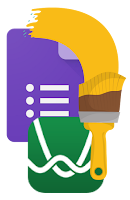Taking a chance on lessons can bring about anxiety...even more so when it's a concept that students struggle with based on your experience. This is how I felt constantly when teaching probability.
Probability is not just the science of chance but also the science of overthinking - at least in my students' eyes. They could understand visually what was occurring, but throw in expected value, standard deviations, random variables, and the eyes begin to aggrandize.
Instead of fighting the uphill battle of "why use these formulas" and the "why did you subtract from 1?" questions, I chose a different approach and created an activity going back to the probability basics - throwing some die around and making some "money".
| Sample Student Work |
Activity: Bunko!
Rules of the Game: Bunko is a game of 3 colored die. Based on what the students roll, you could receive "money". Assume that the die are fair.- If you roll the dice and end up with exactly one die showing a “1”, you win $1.00.
- If exactly two dice show a “1”, you win $2.00.
- If all three dice show a “1”, you win $21.00.
- If all three dice show the same number (any number from 2 to 6) you win $5.00.
- Any other outcome results in $0.00.
- Activity: Bunko - Google Sheet (1 per student)
- Activity: Bunko - Google Slides (1 per student)
- Use this handout if your devices are limited (1 per student)

- Expected Value/weighted averages
- Combining Random Variables (multiple games)
- Law of Large Numbers
- Play 30 rounds of Bunko, recording your answers on the Google Sheet.
- Determine how much money you would win and record it. Watch your counts begin to fill in!
- Open the Google Slides and begin answering your questions.
- Gather all the CLASS data and enter that on your 2nd Tab. You will watch the class counts fill in!
- Create a graphical display of the class data for your Google Slides.
- Go to the Google Slides and answer the remaining questions with a partner.
Teacher Prep: Assign the Google Sheet and Google Slides through Google Classroom where "each student gets a copy."
| Student's Google Slides! Don't have Google Classroom? Change the link from ".../edit" to ".../copy" and share it with them. |
Even though throwing dice can seem trivial, students surprised me by getting so excited! They grasped the concepts at a deeper level and performed stronger on their quiz. Perhaps sharing candy for students who had the most amount of money, least amount of money, and which student had the most significant counts??
At the end, they would want to play more games and determine further probabilities! I used this idea and created a probability game day, where they gathered the experimental probabilities and calculated the theoretical probabilities at home.
Possible Extension for AP Students: Have students run a chi-squared goodness of fit to determine if their individual data was significant using the theoretical probabilities they made on the handout.
Overall, I was thrilled to take a chance and have the students play a game rather than going through additional examples from their textbook. They were more engaged, required to think critically and make connections, and most importantly, they developed a stronger foundation of probability that made the rest of the unit smoother.














